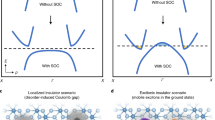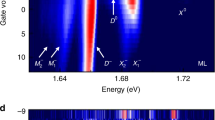Abstract
Monolayer transition-metal dichalcogenides in the T′ phase could enable the realization of the quantum spin Hall effect1 at room temperature, because they exhibit a prominent spin–orbit gap between inverted bands in the bulk2,3. Here we show that the binding energy of electron–hole pairs excited through this gap is larger than the gap itself in the paradigmatic case of monolayer T′ MoS2, which we investigate from first principles using many-body perturbation theory4. This paradoxical result hints at the instability of the T′ phase in the presence of spontaneous generation of excitons, and we predict that it will give rise to a reconstructed ‘excitonic insulator’ ground state5,6,7. Importantly, we show that in this monolayer system, topological and excitonic order cooperatively enhance the bulk gap by breaking the crystal inversion symmetry, in contrast to the case of bilayers8,9,10,11,12,13,14,15,16 where the frustration between the two orders is relieved by breaking time reversal symmetry13,15,16. The excitonic topological insulator is distinct from the bare topological phase because it lifts the band spin degeneracy, which results in circular dichroism. A moderate biaxial strain applied to the system leads to two additional excitonic phases, different in their topological character but both ferroelectric17,18 as an effect of electron–electron interaction.
This is a preview of subscription content, access via your institution
Access options
Access Nature and 54 other Nature Portfolio journals
Get Nature+, our best-value online-access subscription
$29.99 / 30 days
cancel any time
Subscribe to this journal
Receive 12 print issues and online access
$259.00 per year
only $21.58 per issue
Buy this article
- Purchase on Springer Link
- Instant access to full article PDF
Prices may be subject to local taxes which are calculated during checkout





Similar content being viewed by others
Data availability
The data that support the findings of this study are available from the corresponding author upon reasonable request.
Code availability
Many-body perturbation theory calculations were performed by means of the codes Yambo (http://www.yambo-code.org/) and Quantum ESPRESSO (http://www.quantum-espresso.org), which are both open source software. Results for the two-band model were obtained through custom Fortran codes that are available from M.R. upon reasonable request.
References
Kane, C. L. & Mele, E. J. Quantum spin hall effect in graphene. Phys. Rev. Lett. 95, 226801 (2005).
Qian, X., Liu, J., Fu, L. & Li, J. Quantum spin Hall effect in two-dimensional transition metal dichalcogenides. Science 346, 1344–1347 (2014).
Wu, S. et al. Observation of the quantum spin Hall effect up to 100 kelvin in a monolayer crystal. Science 359, 76–79 (2018).
Onida, G., Reining, L. & Rubio, A. Electronic excitations: density-functional versus many-body Green’s-function approaches. Rev. Mod. Phys. 74, 601–659 (2002).
Keldysh, L. V. & Kopaev, Y. V. Possible instability of the semimetallic state against Coulomb interaction. Sov. Phys. Sol. State 6, 2219 (1965); Fiz. Tverd. Tela 6, 2791 (1964).
Jèrome, D., Rice, T. M. & Kohn, W. Excitonic insulator. Phys. Rev. 158, 462 (1967).
Volkov, V. A. & Kopaev, Y. V. Theory of phase transitions in semiconductors of the A4B6 group. Sov. Phys. JETP 37, 1103–1108 (1974); Zh. Eksp. Teor. Fiz. 64, 2184–2915 (1973).
Bernevig, B. A., Hughes, T. L. & Zhang, S.-C. Quantum spin Hall effect and topological phase transition in HgTe quantum wells. Science 314, 1757–1761 (2006).
König, M. et al. Quantum spin hall insulator state in HgTe quantum wells. Science 318, 766–770 (2007).
Liu, C., Hughes, T. L., Qi, X.-L., Wang, K. & Zhang, S.-C. Quantum spin Hall effect in inverted type-II semiconductors. Phys. Rev. Lett. 100, 236601 (2008).
Knez, I., Du, R.-R. & Sullivan, G. Evidence for helical edge modes in inverted InAs/GaSb quantum wells. Phys. Rev. Lett. 107, 136603 (2011).
Budich, J. C., Trauzettel, B. & Michetti, P. Time reversal symmetric topological exciton condensate in bilayer HgTe quantum wells. Phys. Rev. Lett. 112, 146405 (2014).
Pikulin, D. I. & Hyart, T. Interplay of exciton condensation and the quantum spin Hall effect in InAs∕GaSb bilayers. Phys. Rev. Lett. 112, 176403 (2014).
Du, L. et al. Evidence for a topological excitonic insulator in InAs/GaSb bilayers. Nature Commun. 8, 1971 (2017).
Xue, F. & MacDonald, A. H. Time-reversal symmetry-breaking nematic insulators near quantum spin Hall phase transitions. Phys. Rev. Lett. 120, 186802 (2018).
Zhu, Q., Tu, M. W.-Y., Tong, Q. & Yao, W. Gate tuning from exciton superfluid to quantum anomalous Hall in van der Waals heterobilayer. Sci. Adv. 5, eaau6120 (2019).
Portengen, T., Östreich, T. & Sham, L. J. Theory of electronic ferroelectricity. Phys. Rev. B 54, 17452 (1996).
Fei, Z. et al. Ferroelectric switching of a two-dimensional metal. Nature 560, 336–339 (2018).
Jia, Z.-Y. et al.Direct visualization of a two-dimensional topological insulator in the single-layer \(1{T}^{\prime}-{\rm{WT}}{{\rm{e}}}_{2}\). Phys. Rev. B 96, 041108 (2017).
Fei, Z. et al. Edge conduction in monolayer WTe2. Nat. Phys. 13, 677–682 (2017).
Sajadi, E. et al. Gate-induced superconductivity in a monolayer topological insulator. Science 362, 922–925 (2018).
Varsano, D. et al. Carbon nanotubes as excitonic insulators. Nat. Commun. 8, 1461 (2017).
Li, J. I. A., Taniguchi, T., Watanabe, K., Hone, J. & Dean, C. R. Excitonic superfluid phase in double bilayer graphene. Nat. Phys. 13, 751–755 (2017).
Liu, X., Watanabe, K., Taniguchi, T., Halperin, B. I. & Kim, P. Quantum Hall drag of exciton condensate in graphene. Nat. Phys. 13, 746–750 (2017).
Kogar, A. et al. Signatures of exciton condensation in a transition metal dichalcogenide. Science 358, 1314–1317 (2017).
Lu, Y. F. et al. Zero-gap semiconductor to excitonic insulator transition in Ta2 NiSe5. Nat. Commun. 8, 14408 (2017).
Werdehausen, D. et al. Coherent order parameter oscillations in the ground state of the excitonic insulator Ta2NiSe5. Sci. Adv. 4, aap8652 (2018).
Seradjeh, B., Moore, J. E. & Franz, M. Exciton condensation and charge fractionalization in a topological insulator film. Phys. Rev. Lett. 103, 066402 (2009).
Hou, Y. et al. Emergence of excitonic superfluid at topological-insulator surfaces. Preprint at https://arxiv.org/abs/1810.10653 (2018).
Wang, R., Erten, O., Wang, B. & Xing, D. Y. Prediction of a topological p + i p excitonic insulator with parity anomaly. Nat. Commun. 10, 210 (2019).
Qiu, D. Y., da Jornada, F. H. & Louie, S. G. Optical spectrum of MoS2: many-body effects and diversity of exciton states. Phys. Rev. Lett. 111, 216805 (2013).
Berkelbach, T. C. & Reichman, D. R. Optical and excitonic properties of atomically thin transition-metal dichalcogenides. Ann. Rev. Condens. Matter Phys. 9, 379–396 (2018).
Wang, G. et al. Excitons in atomically thin transition metal dichalcogenides. Rev. Mod. Phys. 90, 021001 (2018).
Cao, T. et al. Valley-selective circular dichroism of monolayer molybdenum disulphide. Nat. Commun. 3, 1882 (2012).
Fatemi, V. et al. Electrically tunable low-density superconductivity in a monolayer topological insulator. Science 362, 926–929 (2018).
Giannozzi, P. et al. Quantum ESPRESSO: a modular and open-source software project for quantum simulations of materials. J. Phys. Condens. Matter 21, 395502 (2009).
Perdew, J. P., Burke, K. & Ernzerhof, M. Generalized gradient approximation made simple. Phys. Rev. Lett. 77, 3865 (1996).
Marini, A., Hogan, C., Grüning, M. & Varsano, D. Yambo: an ab initio tool for excited state calculations. Comput. Phys. Commun. 180, 1392–1403 (2009).
Sangalli, D. et al. Many-body perturbation theory calculations using the Yambo code. J. Phys. Condens. Matter 31, 325902 (2019).
Godby, R. W. & Needs, R. J. Metal-insulator transition in Kohn-Sham theory and quasiparticle theory. Phys. Rev. Lett. 62, 1169–1172 (1989).
Rozzi, C. A., Varsano, D., Marini, A., Gross, E. K. U. & Rubio, A. Exact Coulomb cutoff technique for supercell calculations. Phys. Rev. B 73, 205119 (2006).
Kan, M. et al. Structures and phase transition of a MoS2 monolayer. J. Phys. Chem. C 118, 1515–1522 (2014).
Luttinger, J. M. & Kohn, W. Motion of electrons and holes in perturbed periodic fields. Phys. Rev. 97, 869 (1955).
Cudazzo, P., Tokatly, I. V. & Rubio, A. Dielectric screening in two-dimensional insulators: implications for excitonic and impurity states in graphane. Phys. Rev. B 84, 085406 (2011).
Kane, C. L. & Mele, E. J. Z 2 topological order and the quantum spin Hall effect. Phys. Rev. Lett. 95, 146802 (2005).
Acknowledgements
M.P. thanks G. Cicero for illuminating discussions in the early stages of this project and acknowledges Tor Vergata University for financial support through the mission sustainability project 2DUTOPI. This work was supported in part by the MaX (‘MAterials design at the eXascale’, www.max-centre.eu) European Centre of Excellence funded by the European Union H2020-INFRAEDI-2018-1 programme, grant number 824143, project 453. This work was also supported by MIUR-PRIN2017 number 2017BZPKSZ ‘Excitonic insulator in two-dimensional long-range interacting systems (EXC-INS)’. We acknowledge PRACE for awarding us access to the Marconi system based in Italy at CINECA.
Author information
Authors and Affiliations
Contributions
D.V. and M.P. developed the first-principles many-body perturbation theory calculations and analysis; M.R. developed the self-consistent mean-field model and wrote the paper; and all authors initiated this project, contributed to the analysis of data and critically discussed the paper.
Corresponding author
Ethics declarations
Competing Interests
The authors declare that they have no competing financial interests.
Additional information
Peer review information Nature Nanotechnology thanks Onur Erten and the other, anonymous, reviewer(s) for their contribution to the peer review of this work.
Publisher’s note Springer Nature remains neutral with regard to jurisdictional claims in published maps and institutional affiliations.
Extended data
Extended Data Fig. 1 Screened Coulomb interaction.
Comparison between first-principles (black dots) and model (empty red circles) screened Coulomb interaction, W(q), shown as a function of qx, with qy = 0. The plotted data include form factors due to the wave function overlap between Bloch states: the long-wavelength value (q = 0) is extracted from Bloch states located at the Λ point.
Extended Data Fig. 2 Exciton wavefunction within the effective-mass approximation.
Contour plot of the exciton wavefunction square modulus in k space within the electron–hole centre-of-mass frame. This is the lowest-energy exciton responsible for the instability that drives the transition into the QSHX phase. The plot compares well with its first-principles counterpart (Fig. 2b).
Extended Data Fig. 3 Excitonic hybridization and band structure of the trivial ferroelectric excitonic insulator.
a,b, Contour plot in k space of the real (panel a) and imaginary (panel b) part of the self-consistent excitonic hybridization, ΔX(k). c,d, Energy bands along directions kx = 0 (panel c) and ky = Λ (panel d). Black and red curves label opposite spin projections. Since the two-fold screw-axis symmetry along y is broken, Kramers degeneracy is lifted throughout the Brillouin zone. Here T = 0 K and δ = –100 meV.
Supplementary information
Rights and permissions
About this article
Cite this article
Varsano, D., Palummo, M., Molinari, E. et al. A monolayer transition-metal dichalcogenide as a topological excitonic insulator. Nat. Nanotechnol. 15, 367–372 (2020). https://doi.org/10.1038/s41565-020-0650-4
Received:
Accepted:
Published:
Issue Date:
DOI: https://doi.org/10.1038/s41565-020-0650-4
This article is cited by
-
Observation of possible excitonic charge density waves and metal–insulator transitions in atomically thin semimetals
Nature Physics (2024)
-
Evidence of high-temperature exciton condensation in a two-dimensional semimetal
Nature Communications (2023)
-
Efficient GW calculations in two dimensional materials through a stochastic integration of the screened potential
npj Computational Materials (2023)
-
Circularly polarized electroluminescence from a single-crystal organic microcavity light-emitting diode based on photonic spin-orbit interactions
Nature Communications (2023)
-
Strong correlations in two-dimensional transition metal dichalcogenides
Science China Physics, Mechanics & Astronomy (2023)



